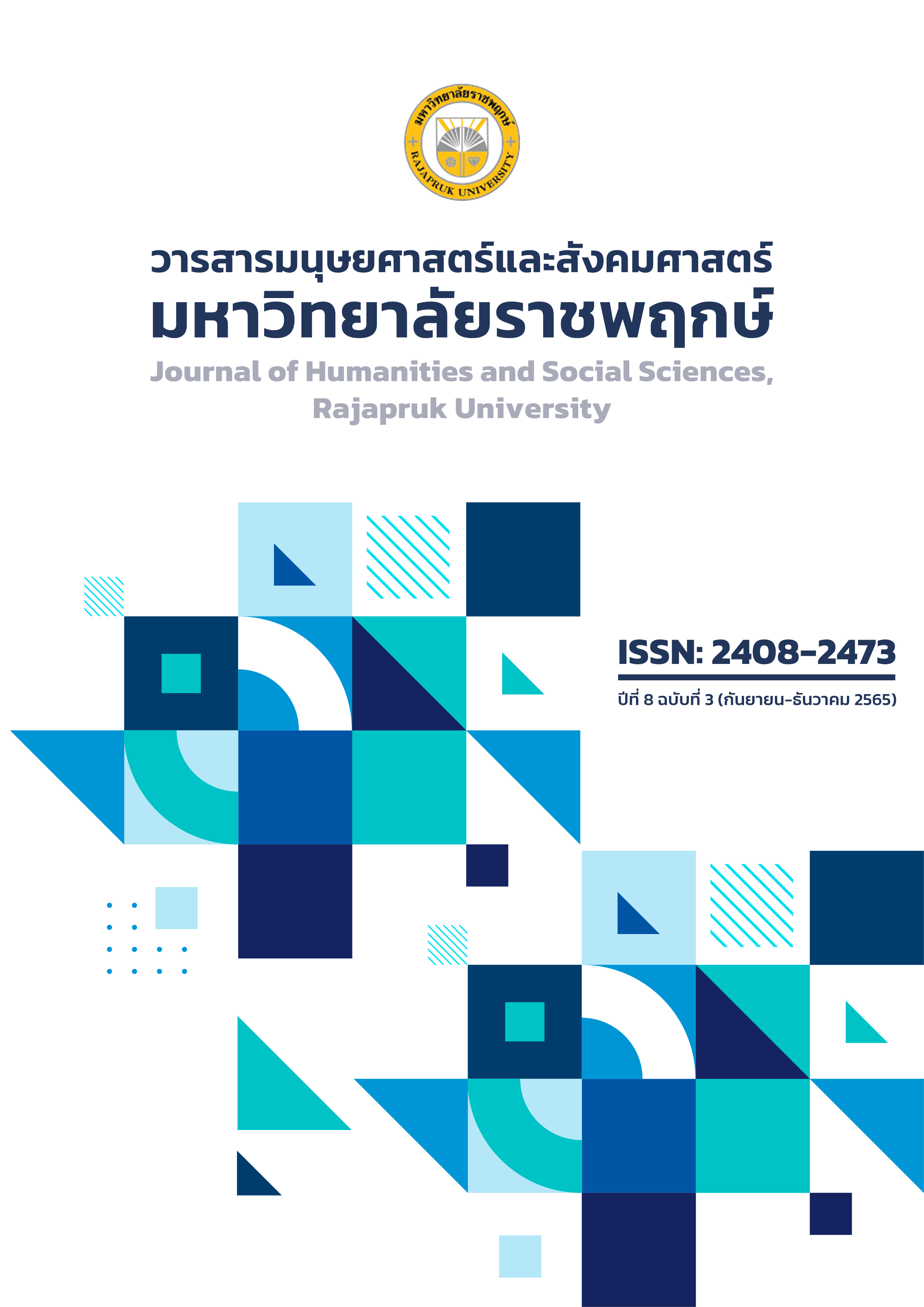A Development Model for the Descendants, Young-Smart Farmers According to the King's Philosophy in the Upper Northern Region
Main Article Content
Abstract
This research aims 1) to analyze factors in developing the descendants, young-smart farmers according to the King's Philosophy in the Upper Northern Region, 2) to construct a model for developing the descendants, young-smart farmers according to the King's Philosophy in the Upper Northern Region, and 3) to determine a model for developing the descendants, young-smart farmers according to the King's Philosophy in the Upper Northern Region. The population in this study was divided into 3 groups. The descendants are young-smart farmers in the upper northern region of 400 people, the second group, 3 main informant groups, a total of 30 people, and the third group. 3 groups of key informants, a total of 33 people. The research instrument had three parts of the questionnaire, the interview form, and the interview evaluation form. Exploratory factor analysis, percentage, mean, standard deviation, and content analysis were employed to carry out the data analysis of important factors.
The findings were found as follows: 1) the factors in developing the descendants, young-smart farmers following the king’s philosophy in the Upper Northern Region consist of 5 important factors as follows: participation in the decision-making process, access to promotion policies of public sectors, management development, understanding and participation in the procedure. 2) A development model for the descendants, young-smart farmers According to the King's Philosophy in the Upper Northern Region consists of 6 parts as follows: context, input, process consisting of 4 dimensions 5 steps 10 processes, output, outcome, and measure of success. And 3) There are four aspects of the form validation: validity, usefulness. possibility and image suitability are included in the criteria by which the model can be implemented.
Article Details
References
กรมการจัดหางาน กองบริหารข้อมูลตลาดแรงงาน. (2560). ยุทธศาสตร์การแก้ไขและป้องกันการขาดแคลนแรงงาน พ.ศ. 2560 – 2565. กรุงเทพฯ: กระทรวงแรงงาน.
กระทรวงเกษตรและสหกรณ์. (2559). แผนพัฒนาการเกษตรในช่วงแผนพัฒนาเศรษฐกิจและสังคมแห่งชาติ ฉบับที่ 12 (พ.ศ.2560-2564). กรุงเทพฯ: กระทรวงเกษตรและสหกรณ์.
กลุ่มพัฒนาเกษตรกร สำนักงานส่งเสริมและพัฒนาการเกษตรที่ 6 ภาคเหนือตอนบน. (2562). จำนวนเกษตรกรรุ่นใหม่ ตั้งแต่ปี พ.ศ.2557-2562 ในเขตภาคเหนือตอนบน. เชียงใหม่: กลุ่มพัฒนาเกษตรกร.
กัลยา วานิชย์บัญชา.(2556). การวิเคราะห์สถิติ: สถิติสำหรับบริหารและวิจัย. พิมพ์ครั้งที่ 10. กรุงเทพฯ: โรงพิมพ์จุฬาลงกรณ์มหาวิทยาลัย.
ทรงเกียรติ อิงคามระธร และคณะ. (2561). การพัฒนาเกษตรกรผู้ปลูกสับปะรดจังหวัดราชบุรี ให้เป็น Smart Farmer โดยการเรียนรู้จาก Smart Farmer ต้นแบบ. รายงานวิจัยฉบับสมบูรณ์ สำนักงานกองทุนสนับสนุนการวิจัย (สกว.).
นาวิน พรมใจสา และคณะ. (2563). เอกสารประกอบการสอน รายวิชาศาสตร์พระราชา. เชียงราย: สำนักวิชาสังคมศาสตร์ มหาวิทยาลัยราชภัฏเชียงราย.
มรกต กำแพงเพชร สวรรยา ธรรมอภิพล และ นรินทร์ สังข์รักษา. (2562). คุณลักษณะผู้ประกอบการเกษตรที่ประสบความสำเร็จในธุรกิจเกษตรสีเขียว. วารสารธุรกิจปริทัศน์, 11 (1) มกราคม-มิถุนายน 2562: 262-275.
มรกต กำแพงเพชร. (2560). การพัฒนารูปแบบการสร้างผู้ประกอบการเกษตรกรปราดเปรื่องในธุรกิจเกษตรอินทรีย์ของประเทศ ไทยยุค 4.0. หลักสูตรปรัชญาดุษฎีบัณฑิต สาขาวิชาการจัดการ มหาวิทยาลัยศิลปากร.
วิทูลย์ แก้วสุวรรณ. (2558). ยุทธศาสตร์การพัฒนาชุมชนตามแนวปรัชญาเศรษฐกิจพอเพียง. ดุษฎีนิพนธ์ รัฐประศาสนศาสตรดุษฎีบัณฑิต สาขาวิชารัฐประศาสนศาสตร์ มหาวิทยาลัยราชภัฏวไลยอลงกรณ์ ในพระบรมราชูปถัมภ์.
ศรายุทธ รัตนปัญญา และคณะ. (2559). การพัฒนารูปแบบการประเมินสมรรถนะโดยประยุกต์ใช้การประเมินแบบเสริมพลังอำนาจสำหรับผู้บริหารสถานศึกษาใหม่สังกัดสำนักงานคณะกรรมการการศึกษาขั้นพื้นฐาน. วารสารบัณฑิตศึกษา มหาวิทยาลัยราชภัฏสกลนคร, 13(60) มกราคม-มีนาคม 2559: 201-212.
Cronbach, Lee. J. (1990). Essentials of Psychology Testing. 5th ed. New York: Harper Collins Publishers Inc.
Eisner, E. (1976). Educational connoisseurship and criticism: Their form and functions in education evaluation. Journal of Aesthetic Education, 39(2): 192-193.
Field, A. P., Miles, J., & Field, Z. (2012). Discovering statistics using R. Thousand Oaks, CA: Sage.
Guo, G., Wen, Q., & Zhu, J. (2015). The impact of aging agricultural labor population on farmland output: from the perspective of farmer preferences. Mathematical Problems in Engineering. the Project Guide Research Fund of Philosophy and Social Science in Colleges and Universities in Jiangsu.
Hair, J. F., Tatham, R. L., Anderson, R. E., & Black, W. (1998). Multivariate data analysis. 5th ed. Upper Saddle River, NJ: Prentice Hall.
Ketelaar-de Lauwere, Carolien, Ina Enting, Peter Vermeulen, and Kees Verhaar. (2002). Modern Agricultural Entrepreneurship. Paper presented at the International Farm Management Association, 13th Congress.
McElwee, Gerard. (2006). Farmers as Entrepreneurs: Developing Competitive Skills. Journal of developmental entrepreneurship, 11(3): 187-206.
Ozimek, A., DeAntonio, D., & Zandi, M. (2018). Aging and the Productivity Puzzle. Retrieved on June 8th, 2020, from https://ma.moodys.com/rs/961-KCJ-308/images/2018-09-04-Aging-and-the-Productivity-Puzzle.pdf


